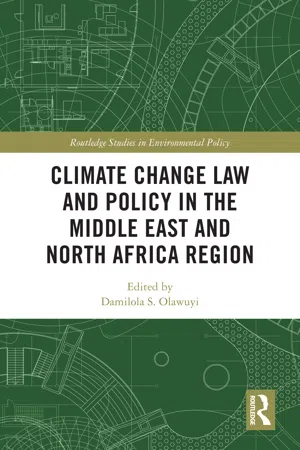Damilola S. Olawuyi
Introduction
The aim of this book is to examine the guiding principles of climate change law and policy in the Middle East and North Africa (MENA) region.1 It explores the applicable legislation, institutions, as well as lessons learned from emerging innovative and bottom-up approaches to climate regulation across the region. It also provides holistic assessments and reflections on how MENA countries can advance existing national strategies and visions on climate change, through clear and comprehensive legislation.
Climate change is one of the greatest concerns facing our present generation.2 Simply defined, climate change is an increase in the average temperature of the atmosphere at an abnormal rate, caused mainly by the anthropogenic (human-induced) emission of gases known as greenhouse gases (GHGs) that trap the sun’s heat in the atmosphere.3 GHGs that contribute to climate change include carbon dioxide (CO2); nitrous oxides (N2O); water vapour (H2O); short-lived climate pollutants (SLCPs),4 such as black carbon, methane (CH4), tropospheric ozone (O3); and fluorinated gases, such as chlorofluorocarbons (CFCs), hydrofluorocarbons (HFCs), perfluorocarbons (PFCs), and sulfur hexafluoride (SF6).5 These GHGs, which are mainly by-products of industrial activities, absorb heat radiation that should normally escape to space, thereby heating the atmosphere at an abnormal rate. Due to increasing human dependence on the combustion of fossil fuels, such as coal, oil, and gas, that emit GHGs, the concentrations of GHGs in the atmosphere are increasing at exponential and alarming rates.6 For example, in 2013, scientific studies concluded that atmospheric concentrations of CO2 (one of the potent GHGs) exceeded 400 parts per million for the first time in human history, while the emissions of other GHGs, such as methane and nitrous oxide, have continued to increase.7 With the increased manifestation of extreme weather events across the world, such as devastating floods, droughts, and tropical cyclones across the MENA region,8 there is now increased consensus that human activity is disrupting the global climate system; and that if left unchecked, the direct and indirect effects of climate change may threaten lives, livelihoods, and public infrastructure all over the world.9
Climate change poses even more serious economic, social, and environmental threats to the MENA region—arguably, more so than any other region in the world. Although the MENA region is not one homogeneous geographical unit, MENA countries have historical similarities in culture, language (Arabic), religion (Islam), geography, as well as in their contributions and vulnerabilities to climate change.10 The MENA region, especially the Gulf countries—Kuwait, Iran, Bahrain, Oman, Qatar, Saudi Arabia, and the United Arab Emirates (UAE)—is home to some of the world’s highest exporters of oil and natural gas.11 Also, for many years, the oil sector has accounted for over 80 per cent of export earnings in North African countries such as Egypt, Libya, and Algeria.12 Due to the fossil fuel-dependent nature of the economies of several MENA countries, the MENA region has the fastest growth rate in GHG emissions globally.13 For example, in 2018, the MENA region was responsible for 3.2 billion tonnes of CO2 and 8.7 per cent of global GHGs.14 Efforts to address global climate change, and the growing transition away from carbon-intensive fossil fuels across the world, could, therefore, result in fundamental changes in the economies, energy mix, lifestyles, and overall development of several MENA countries.15
More importantly, climate change raises complex existential threats to several MENA countries.16 Apart from the unique geographical vulnerabilities of MENA countries, which contribute to their low adaptive capacity, the region is home to a number of small and low lying islands, such as Qatar and Bahrain, countries that have a dual vulnerability to climate change, both as arid countries and as small island developing states.17 Even without climate change, several MENA countries are currently subjected to arid and desert-like conditions which typically make farming and agriculture difficult and near impossible. As such, climate change would only escalate these pre-existing social, economic, and environmental conditions, and could intensify the cycle of food shortage, desertification, water scarcity, depleting fish stocks, and the spread of diseases in the MENA region.18 Recent World Bank studies indicate that the MENA region is expected to have the greatest economic losses from climate-related water scarcity, estimated at 6 to 14 per cent of the gross domestic product (GDP) by 2050.19 For example, the MENA region is home to 12 out of the world’s 17 most water-stressed countries.20
Apart from climate-induced water scarcity, flooding, and fatal heat waves, climate change could have wide-ranging effects on extant and future infrastructure in MENA countries.21 This includes the potential failure of facilities, reduced life expectancy of buildings, and an increased operational and maintenance expenditure of electricity, water, and aviation infrastructure, amongst others.22 To effectively address the impacts of climate change on critical infrastructure in the MENA region, there is a need for increased investment in climate-smart infrastructure, i.e. buildings, structures, and systems that reduce GHG emissions, and improve society’s ability to adapt to, and cope with, the risks posed by climate change.23
Despite the grim reality of climate change, the MENA region remains one of the least prepared regions facing it.24 Clear and comprehensive legal frameworks on climate change have not been so easily forthcoming in many parts of the region. Furthermore, climate change education is still at an alarming stage of infancy in the region.25 Currently, only very few universities in the MENA region have dedicated law courses that advance knowledge and capacity on climate change law. According to the findings of recent regional conferences on environmental law, one key reason for the slow pace of environment legal education in the region is the absence of an authoritative text that unpacks the nature and guiding principles of climate change law and policy in the region.26 While earlier scholarships have provided country-focused analyses on climate change in select countries and sectors, a detailed, authoritative, and book-length exposition of the multi-dimensional, region-wide, and intersectional nature of climate change law and policy in the MENA region has remained absent. This book fills that gap.
T...
